
Vermont

Every child deserves the opportunity to succeed in society – and tax policy has a huge role to play in making that happen. Better tax policy can help prepare our young children with skills to become successful and thriving adults.

These forward-thinking states are demonstrating the wide variety of options for policymakers who want to raise more from the wealthiest people, rein in corporate tax avoidance, create fair tax codes and build strong communities.
Vermont Lt. Gov David Zuckerman: Fair Share
March 14, 2024
Today, I have an exceptionally important topic to talk about: taxes! Taxes have become a dirty word, and in many ways for good reason. Since the 1980’s there has been a significant shift in how much everyday people pay in taxes. Wealthy and high-income individuals have seen their marginal tax rates drop precipitously, while working […]
ITEP’s Carl Davis: Who Pays Vermont Taxes?
January 29, 2024
ITEP Research Director Carl Davis gave a presentation on Vermont’s tax system to that state’s Ways and Means Committee on January 25, 2024. Click here for the slide deck.
CBS News: Vermont Wants to Fix Income Inequality by Raising Taxes on the Rich
January 29, 2024
Across the U.S., the rich generally pay a lower share of their income in taxes than low earners, according to the Institute on Taxation and Economic Policy (ITEP). A recent analysis by the left-leaning think tank found that the average effective state and local tax rate paid by residents to their home state is 7.2% for the top 1% of earners; for the lowest-earning 20%, that rate tops 11%.
New York Times: Vermont Becomes Latest State to Propose Wealth Taxes
January 23, 2024
Lawmakers in Vermont are introducing legislation this week that would impose new taxes on the state’s wealthiest residents, joining a growing national campaign being pushed by Democrats who believe that the measures will gain traction as states reckon with post-pandemic budget squeezes
Vermont: Who Pays? 7th Edition
January 9, 2024 • By ITEP Staff
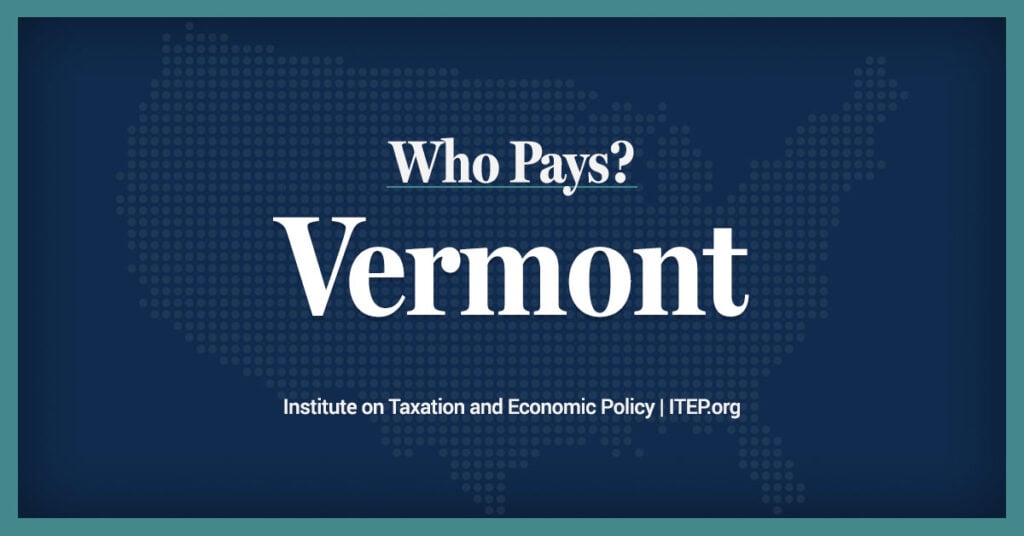
Vermont Download PDF All figures and charts show 2024 tax law in Vermont, presented at 2023 income levels. Senior taxpayers are excluded for reasons detailed in the methodology. Our analysis includes nearly all (99.7 percent) state and local tax revenue collected in Vermont. State and local tax shares of family income Top 20% Income Group […]
Public Assets Institute: A Fairer Tax System Would Help Working Families
November 29, 2018
The report looks at how well states distribute taxes based on family incomes. In most states lower-income families pay a higher percentage of their income in state and local taxes than those at the top. That’s the definition of a regressive tax system. Vermont’s is one of the least regressive in the country.
Rutland Herald: In All Fairness
October 18, 2018
Anti-tax advocates across the country and in Vermont continue to push for policies that reduce tax rates for the wealthy and businesses, the report finds. However, a movement is growing in opposition to this agenda, as the public realizes that tax cuts for the wealthy and corporations mean less money to fund the things that benefit everyone: schools, parks and public spaces, infrastructure, public safety and other basic services.
Public Assets Institute: New report: Vermont’s Tax System Is Among the Least Regressive
October 17, 2018
Tax systems generally favor the wealthy, but Vermont’s system is skewed less than most other states when it comes to high-income taxpayers. That was the key finding of a study released today by the Institute on Taxation and Economic Policy (ITEP) and Public Assets Institute.
Vermont: Who Pays? 6th Edition
October 17, 2018 • By ITEP Staff
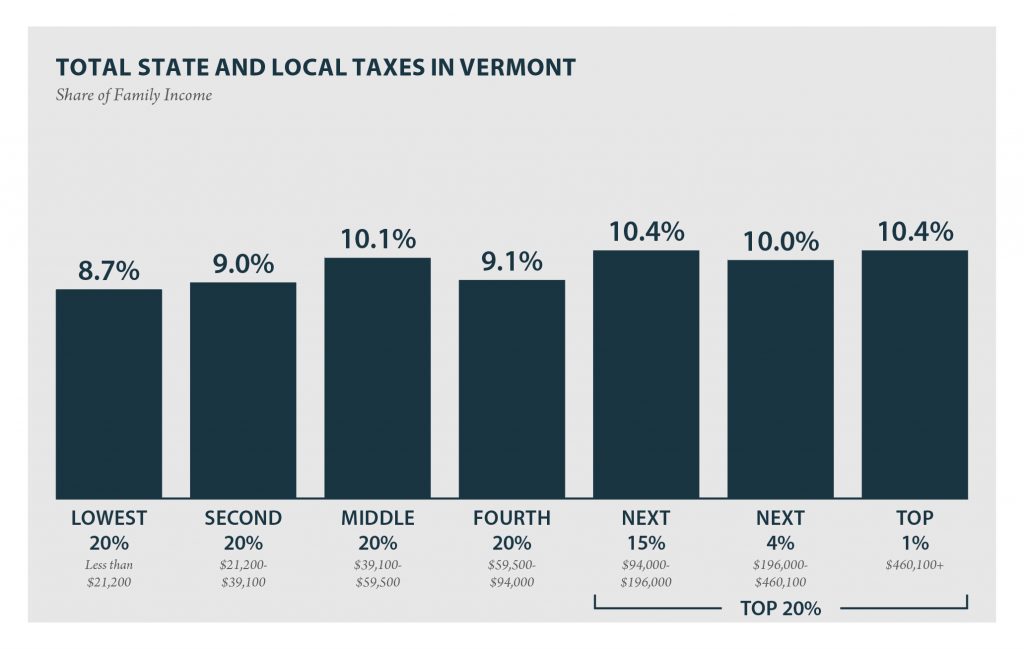
VERMONT Read as PDF VERMONT STATE AND LOCAL TAXES Taxes as Share of Family Income Top 20% Income Group Lowest 20% Second 20% Middle 20% Fourth 20% Next 15% Next 4% Top 1% Income Range Less than $21,200 $21,200 to $39,100 $39,100 to $59,500 $59,500 to $94,000 $94,000 to $196,000 $196,000 to $460,100 over $460,100 […]
Tax Cuts 2.0 – Vermont
September 26, 2018 • By ITEP Staff
The $2 trillion 2017 Tax Cuts and Jobs Act (TCJA) includes several provisions set to expire at the end of 2025. Now, GOP leaders have introduced a bill informally called “Tax Cuts 2.0” or “Tax Reform 2.0,” which would make the temporary provisions permanent. And they falsely claim that making these provisions permanent will benefit […]
Building on Momentum from Recent Years, 2018 Delivers Strengthened Tax Credits for Workers and Families
July 10, 2018 • By Aidan Davis

Despite some challenging tax policy debates, a number of which hinged on states’ responses to federal conformity, 2018 brought some positive developments for workers and their families. This post updates a mid-session trends piece on this very subject. Here’s what we have been following:
Gas Taxes Rise in Seven States, Including an Historic Increase in Oklahoma
June 26, 2018 • By Carl Davis
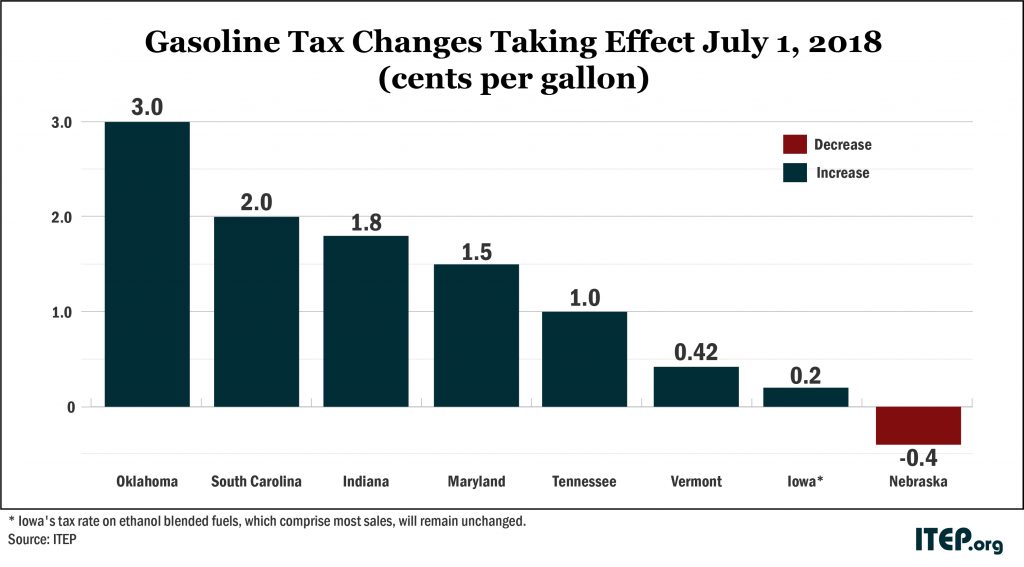
A rare sight is coming to Oklahoma. The last time the Sooner State raised its gas tax rate, the Berlin Wall was still standing, and Congress was debating whether to ban smoking on flights shorter than two hours. Fast forward 31 years, and Oklahoma is finally at it again. On Sunday, the state’s gas tax rate will rise by 3 cents and its diesel tax rate by 6 cents. Both taxes will now stand at 19 cents per gallon—still among the lowest in the country. But Oklahoma isn’t the only state where gas taxes will soon rise.
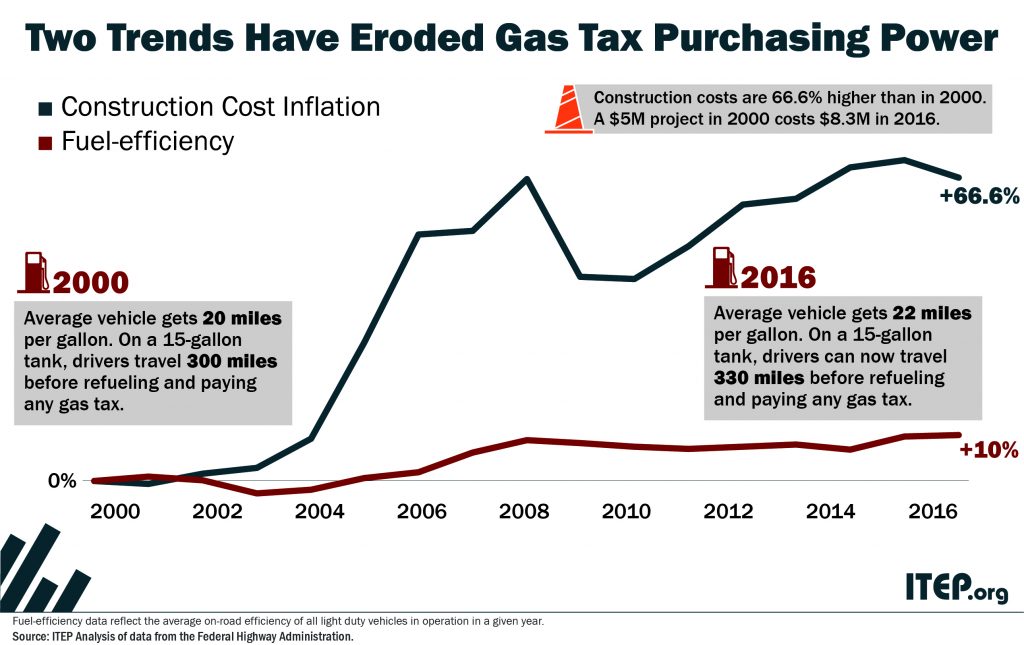
An updated version of this blog was published in April 2019. State tax policy can be a contentious topic, but in recent years there has been a remarkable level of agreement on one tax in particular: the gasoline tax. Increasingly, state lawmakers are deciding that outdated gas taxes need to be raised and reformed to fund infrastructure projects that are vital to their economies.
How the Final GOP-Trump Tax Bill Would Affect Vermont Residents’ Federal Taxes
December 16, 2017 • By ITEP Staff
The final tax bill that Republicans in Congress are poised to approve would provide most of its benefits to high-income households and foreign investors while raising taxes on many low- and middle-income Americans. The bill would go into effect in 2018 but the provisions directly affecting families and individuals would all expire after 2025, with […]
How the House and Senate Tax Bills Would Affect Vermont Residents’ Federal Taxes
December 6, 2017 • By ITEP Staff
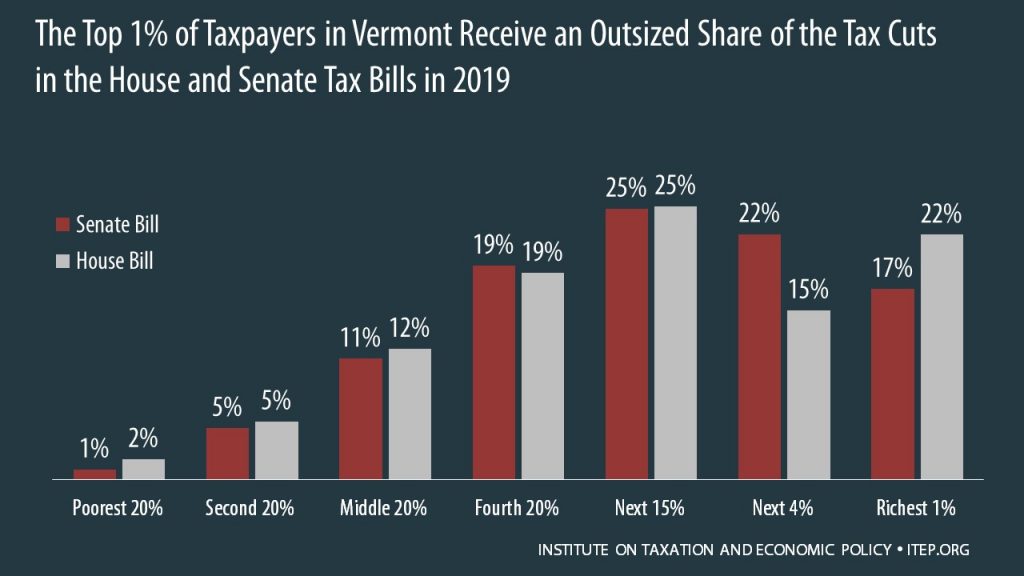
The House passed its “Tax Cuts and Jobs Act” November 16th and the Senate passed its version December 2nd. Both bills would raise taxes on many low- and middle-income families in every state and provide the wealthiest Americans and foreign investors substantial tax cuts, while adding more than $1.4 trillion to the deficit over ten years. The graph below shows that both bills are skewed to the richest 1 percent of Vermont residents.
How the Revised Senate Tax Bill Would Affect Vermont Residents’ Federal Taxes
November 14, 2017 • By ITEP Staff
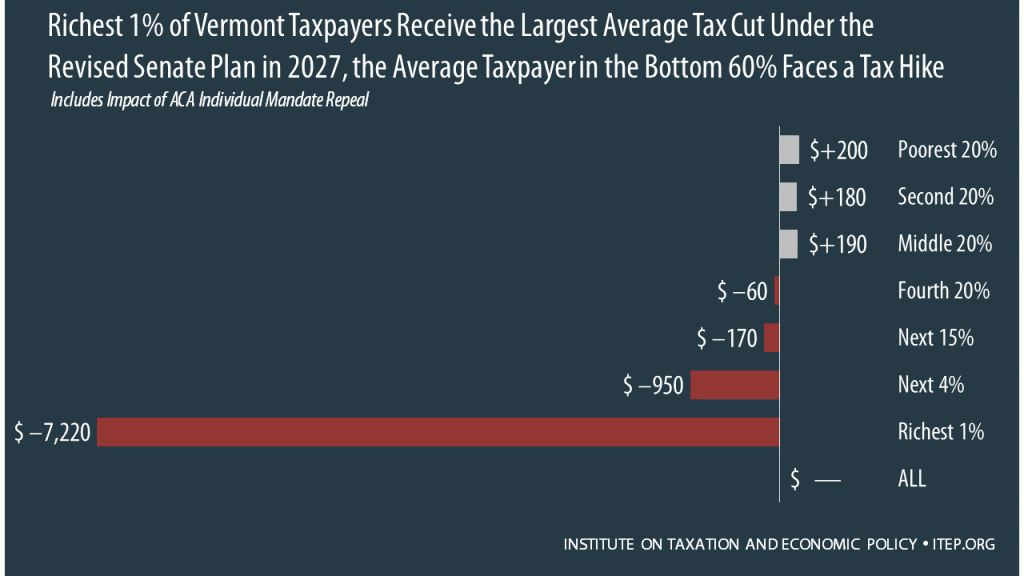
The Senate tax bill released last week would raise taxes on some families while bestowing immense benefits on wealthy Americans and foreign investors. In Vermont, 40 percent of the federal tax cuts would go to the richest 5 percent of residents, and 11 percent of households would face a tax increase, once the bill is fully implemented.
How the House Tax Proposal Would Affect Vermont Residents’ Federal Taxes
November 6, 2017 • By ITEP Staff
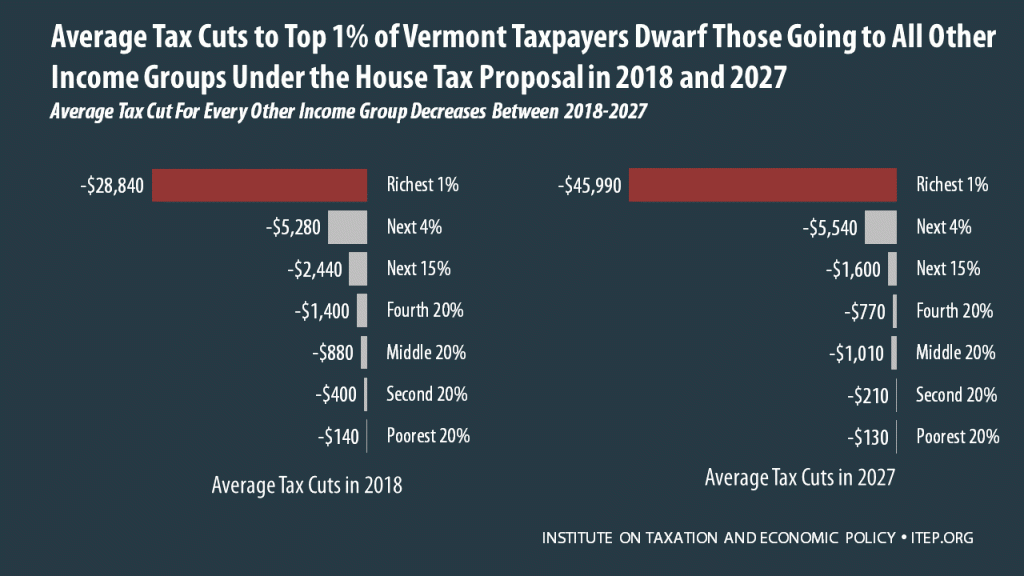
The Tax Cuts and Jobs Act, which was introduced on November 2 in the House of Representatives, includes some provisions that raise taxes and some that cut taxes, so the net effect for any particular family’s federal tax bill depends on their situation. Some of the provisions that benefit the middle class — like lower tax rates, an increased standard deduction, and a $300 tax credit for each adult in a household — are designed to expire or become less generous over time. Some of the provisions that benefit the wealthy, such as the reduction and eventual repeal of the estate…
GOP-Trump Tax Framework Would Provide Richest One Percent in Vermont with 45.1 Percent of the State’s Tax Cuts
October 4, 2017 • By ITEP Staff
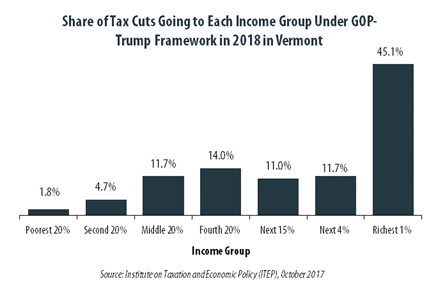
The “tax reform framework” released by the Trump administration and congressional Republican leaders on September 27 would not benefit everyone in Vermont equally. The richest one percent of Vermont residents would receive 45.1 percent of the tax cuts within the state under the framework in 2018. These households are projected to have an income of at least $505,400 next year. The framework would provide them an average tax cut of $45,250 in 2018, which would increase their income by an average of 3.8 percent.
In Vermont 27.8 Percent of Trump’s Proposed Tax Cuts Go to People Making More than $1 Million
August 17, 2017 • By ITEP Staff
A tiny fraction of the Vermont population (0.3 percent) earns more than $1 million annually. But this elite group would receive 27.8 percent of the tax cuts that go to Vermont residents under the tax proposals from the Trump administration. A much larger group, 41.5 percent of the state, earns less than $45,000, but would receive just 7.1 percent of the tax cuts.
Trump Tax Proposals Would Provide Richest One Percent in Vermont with 39.1 Percent of the State’s Tax Cuts
July 20, 2017 • By ITEP Staff
Earlier this year, the Trump administration released some broadly outlined proposals to overhaul the federal tax code. Households in Vermont would not benefit equally from these proposals. The richest one percent of the state’s taxpayers are projected to make an average income of $1,192,800 in 2018.
State Rundown 6/28: States Scramble to Finish Budgets Before July Deadlines
June 28, 2017 • By ITEP Staff
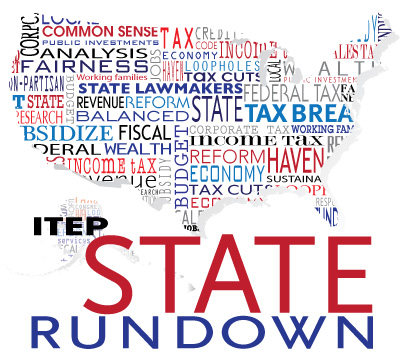
This week, several states attempt to wrap up their budget debates before new fiscal years (and holiday vacations) begin in July. Lawmakers reached at least short-term agreement on budgets in Alaska, New Hampshire, Rhode Island, and Vermont, but such resolution remains elusive in Connecticut, Delaware, Illinois, Maine, Pennsylvania, Washington, and Wisconsin.

This week, we celebrate a victory in Kansas where lawmakers rolled back Brownback's tax cuts for the richest taxpayers. Governors in West Virginia and Alaska promote compromise tax plans. Texas heads into special session and Vermont faces another budget veto, while Louisiana and New Mexico are on the verge of wrapping up. Voters in Massachusetts may soon be able to weigh in on a millionaire's tax, the California Senate passed single-payer health care, and more!
Investors and Corporations Would Profit from a Federal Private School Voucher Tax Credit
May 17, 2017 • By Carl Davis
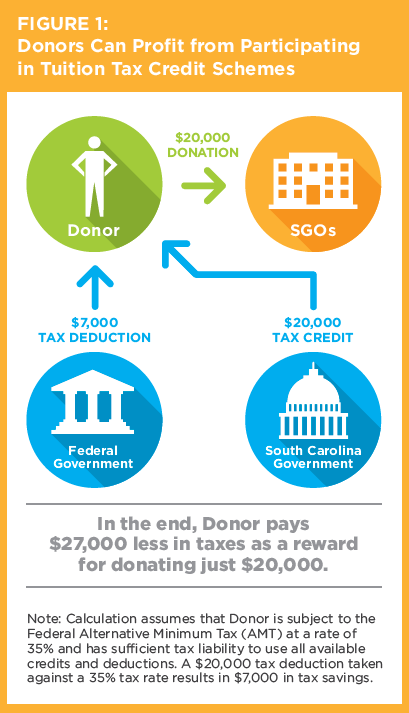
A new report by the Institute on Taxation and Economic Policy (ITEP) and AASA, the School Superintendents Association, details how tax subsidies that funnel money toward private schools are being used as profitable tax shelters by high-income taxpayers. By exploiting interactions between federal and state tax law, high-income taxpayers in nine states are currently able […]
